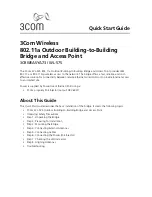
Chapter 3: System planning
Radio Frequency planning
Page
3-18
Certain regulations have allocated certain channels as unavailable for use:
•
FCC has allocated part of the 5.1 & 5.2 GHz
•
ETSI has allocated part of the 5.4 GHz band to weather radar.
•
UK and some other European countries have allocated part of the 5.8 GHz band to Road Transport
and Traffic Telematics (RTTT) systems.
The number and identity of channels barred in a given regulatory band is dependent on the channel
bandwidth and channel raster selected.
Analyzing the RF Environment
An essential element in RF network planning is the analysis of spectrum usage and the strength of the
signals that occupy the spectrum. Regardless of how these parameters are measured and log or chart
the results (through the Spectrum Analyzer feature or by using a spectrum analyzer), ensure
measurements are performed:
•
At various times of day.
•
On various days of the week.
•
Periodically into the future.
As new RF neighbors move in or consumer devices proliferate in currently used spectrum, this keeps
the user aware of the dynamic possibilities for interference within the network.
Channel bandwidth
Select the required channel bandwidth for the link. The selection depends upon the regulatory band
selected.
The wider the channel bandwidth, the greater the capacity. As narrower channel bandwidths take up
less spectrum, selecting a narrow channel bandwidth may be a better choice when operating in
locations where the spectrum is very busy.
Both ends of the link must be configured to operate on the same channel bandwidth.
Anticipating Reflection of Radio Waves
In the signal path, any object that is larger than the wavelength of the signal can reflect the signal. Such
an object can even be the surface of the earth or of a river, bay or lake. The wavelength of the signal is
approximately
•
2 inches (or 5 cm) for 5.4 GHz and 5.8 GHz signals.
•
12 inches for 900 MHz signals
A reflected signal can arrive at the antenna of the receiver later than the non-reflected signal arrives.
These two or more signals cause the condition known as multipath. Multipath may increase or decrease
the signal level, resulting in overall attenuation that may be higher or lower than that caused by the link
distance. This is problematic at the margin of the link budget, where the standard operating margin
(fade margin) may be compromised.
Содержание PMP 450 AP
Страница 79: ...Chapter 2 System hardware System Components Page 2 29 Figure 20 Gigabit Enet Capable power supply...
Страница 160: ...Chapter 3 System planning Radio Frequency planning Page 3 30 Figure 55 Sector Antenna...
Страница 161: ...Chapter 3 System planning Radio Frequency planning Page 3 31 Figure 56 cnMedusa Antenna...
Страница 189: ...Chapter 3 System planning Remote AP Deployment Page 3 59 Figure 65 Remote AP wired to SM that serves as a relay...
















































